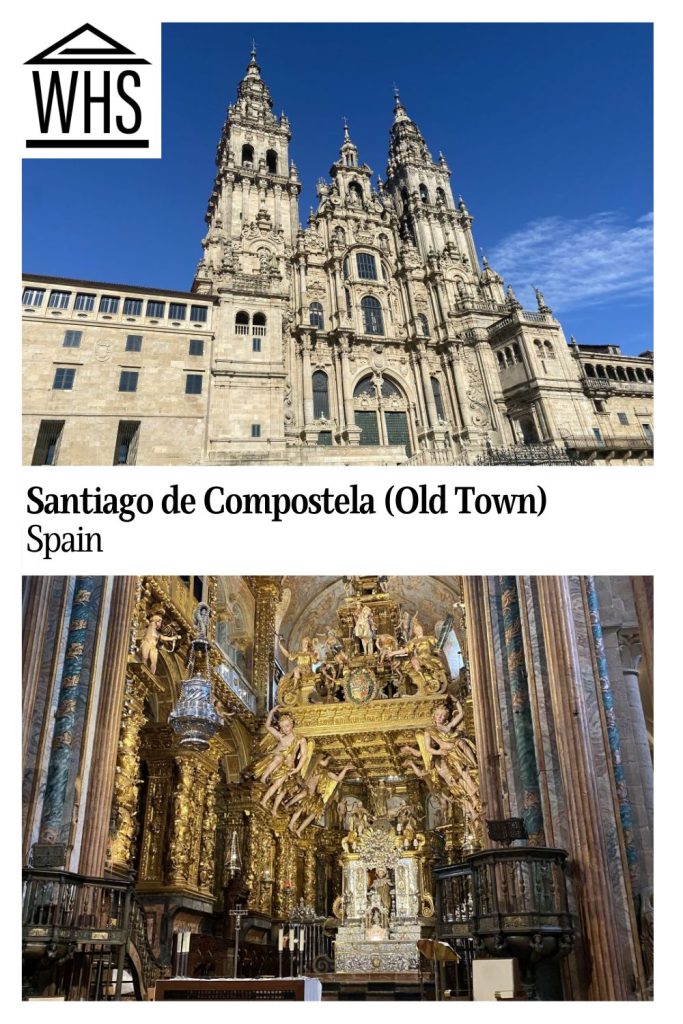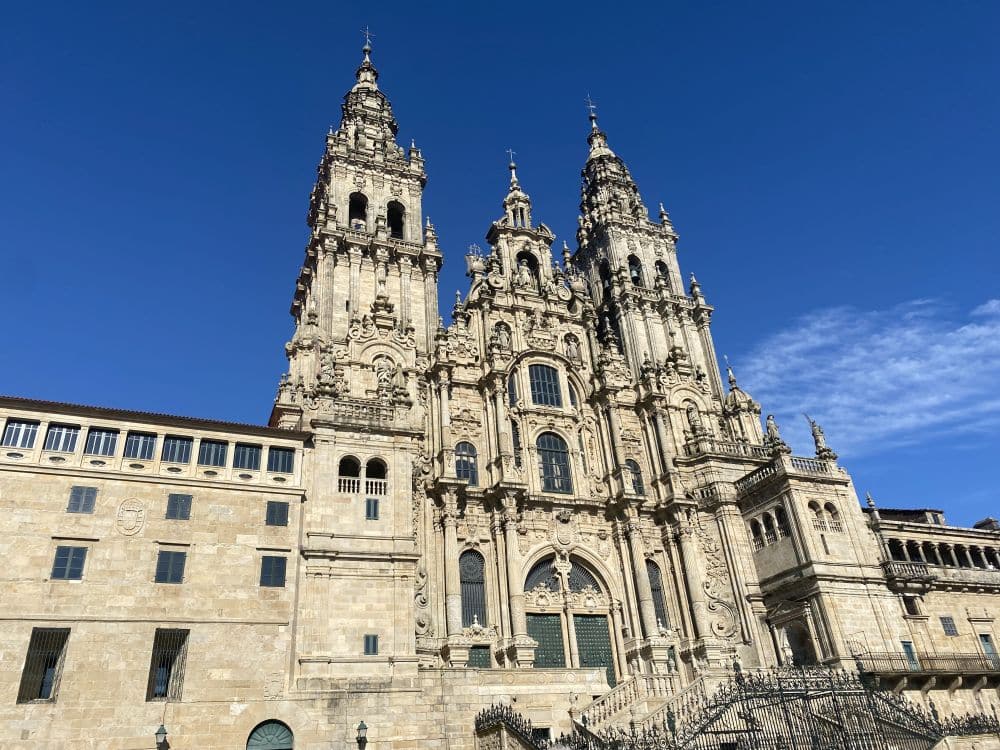Santiago de Compostela (Old Town)
By Mikala Whitaker
What is Santiago de Compostela (Old Town)?
Santiago de Compostela’s Old Town is most well-known for allegedly being home to the remains of Saint James. The story goes that a hermit discovered the remains of Saint James in the 9th century not far from the city. The remains were moved to the city, and since then, Santiago de Compostela has been visited by millions of pilgrims hiking the Camino de Santiago.
Disclosure: This article contains affiliate links. Making a purchase through an affiliate link will mean a small commission for this website. This will not affect your price.

On the edge of the city, the Romanesque-style Santa Maria del Conxo Monastery is also part of this UNESCO designation. Some elements of the building date to the 12th century, but most of it is from the 18th century. Now a psychiatric hospital, it can only be visited by special arrangement. The monastery church (17th-century), however, is still an active church and is open for mass.
Why is Santiago de Compostela (Old Town) a UNESCO World Heritage site?
Santiago de Compostela is considered “one of Christianity’s greatest holy cities” according to UNESCO. The city was destroyed by Muslims in the 10th century and later rebuilt. This time period made Santiago de Compostela a symbol of the Christians’ struggles against Islam in Spain.
According to UNESCO, the Cathedral in Santiago is a “masterpiece of Romanesque art.” The town “exerted a decisive influence on the development of architecture and art” both Romanesque and Baroque.

What can you expect on a visit to Santiago de Compostela?
I visited Santiago myself after spending 33 days hiking almost 500 miles across Spain along the Camino Francés route of the Camino de Santiago.
Walking the stone streets of the Old Town feels like stepping into another time. The buildings have been well preserved, and you’ll find a mix of elements from the Middle Ages, Renaissance, and 17th and 18th centuries. There’s a special magic to the town. Without a doubt, a lot of that is due to the Camino de Santiago. Outside of the cathedral, you’ll see all sorts of emotions as pilgrims hobble in, finally reaching their long-awaited destination.
The cathedral is, of course, the main highlight in the city, but there are so many things to do in Santiago de Compostela. Some other highlights include exploring the Mercado de Abastos food market, taking a walk through Alameda Park, and getting an affordable massage.

Is Santiago de Compostela worth visiting?
If you have limited time in Spain and want to focus on the main highlights, then I wouldn’t say it’s worth squeezing Santiago into your trip. However, if you’re planning a trip to see northern Spain, then I would absolutely include it on your list.
You can see most of the highlights in one day, but I recommend spending two to three days here if possible. You could also spend more time here and use Santiago de Compostela as a base to take day trips around the region of Galicia. Use the map below to book your accommodations:
What sorts of travelers would like Santiago de Compostela?
If you’re interested in religion, history, and old architecture, then you would love visiting Santiago. This is also the best place to learn about the Camino de Santiago and see some of it firsthand.
If you’ve seen some of the main tourist areas of Spain and are looking for something different, then I recommend visiting Santiago de Compostela. The city is the capital of Galicia, which is often known as the Scotland of Spain due to its lush green surroundings and Celtic heritage. Galicia and the nearby Asturias are some of the most beautiful areas of Spain. Yet they are often overlooked by international tourists visiting the country.

Tips for Visiting Santiago
I recommend attending a pilgrim’s Mass at the cathedral. There, you’ll be able to take in the many pilgrims who have just completed their long journeys. Plus, if you’re lucky, you’ll see the unique 116-pound (53 kg) swinging incense called the Botafumeiro.
You can sign up for a guided tour of the cathedral, including admission, or a half-day guided tour of the town and cathedral, including admission.
In addition, you can take a tour of the cathedral’s rooftops. The guided tour is in Spanish, but even if you don’t know the language, it’s a cool way to see more of the cathedral and the city.
Don’t miss the Mercado de Abastos, a food market offering a mix of fresh ingredients and meals you can enjoy there.
As you think about when to visit the city, I recommend going between June and September. That’s the peak time of year for pilgrims to arrive as they complete the Camino de Santiago. Weather is better during these months as well because this region is generally cooler in temperature than many other parts of Spain.
For an extra special experience, consider visiting during the last two weeks of July. These weeks are filled with parades, performances, fireworks, and more in celebration of Saint James Day on July 25.
I personally visited in June and felt like it was a great time to be in the city. It was busy with many pilgrims and other visitors in town, but it never felt overwhelmingly full of people.

If you’re looking to visit other UNESCO World Heritage sites, the following are fairly close to Santiago de Compostela:
- Roman Walls of Lugo—around 1 hour away by car and 2 hours away by bus
- Tower of Hercules—around 1 hour away by car and 1.5 hours away by train
- Monuments of Oviedo and the Kingdom of Asturias—around 3 hours away by car
- Las Médulas—around 2.5 hours away by car
- And, of course, the Routes of Santiago de Compostela: Camino Francés and Routes of Northern Spain and the Routes of Santiago de Compostela in France, both of which are UNESCO sites, separate from Santiago’s Old Town.
Where is Santiago de Compostela?
The city is located in the autonomous community of Galicia in Spain just north of Portugal. The Old Town lies in the center of the city around the cathedral.
The city has a fairly large airport and can be reached by plane, but you may have a layover to get there depending on where you’re coming from. If you’re coming from Madrid, you can take a train and get there in 3 to 4 hours.
Buses are a great option as well, especially if you’re coming from another northern Spanish city or from Portugal. The bus from Porto to Santiago de Compostela takes about 3 to 4 hours.
If you’re traveling around northern Spain in a short amount of time, then renting a car may be your best option for getting to Santiago and exploring other places along the way. For instance, it takes about 6 hours to drive from Bilbao to Santiago de Compostela but over 10 hours via public transit with multiple transport changes.
For more information about Santiago de Compostela, see its tourism website.
Have you been to Santiago de Compostela? If so, do you have any additional information or advice about this UNESCO World Heritage site? Please add your comments below!

